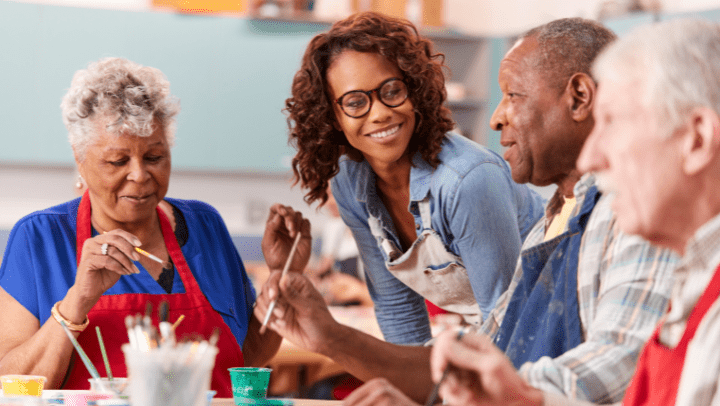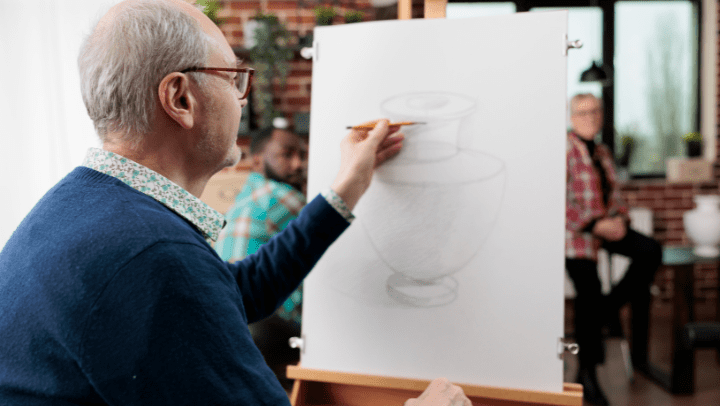
The statistics paint a stark picture. One in ten people show signs of Alzheimer’s disease by age 65. This number jumps dramatically to one in three by age 85. American families face growing challenges as their loved ones live longer and need support through memory loss.
Art offers unexpected hope. People with memory loss can lead happier, healthier and more connected lives through painting, music or dance. Art therapy creates a powerful non-verbal communication channel that reduces isolation and anxiety while improving life quality. The role of art in cognitive health becomes crucial when you’re learning about memory care. This knowledge helps make informed decisions about care options.
Brain function and art share a fascinating connection. This piece explains their relationship, suggests creative activities and highlights scientifically-proven benefits of art in memory care routines.
Understanding Art and Brain Connection
Studies show that creating and appreciating art activates multiple brain regions at once and builds new neural connections that improve cognitive function. We observed that artistic experiences tap into both perceptual processes and advanced cognitive functions like memory, attention and emotional processing.
Your brain goes through essential changes at the neurobiological level while you create art. Neural networks modify their synaptic connections through repeated activation, which scientists call experience-dependent plasticity. The brain releases neurotransmitters linked to pleasure and motivation, so it promotes cognitive well-being.
Art’s impact on the brain goes beyond just looking at it. Creating and viewing art activate the prefrontal cortex and temporal regions – areas that are vital for memory processing and emotional regulation. This pattern explains why art therapy works so well for improving cognitive function.
Art and memory share a deep connection. Studies show that semantic memory – knowing how to retrieve information from long-term memory – plays a key role in both verbal and nonverbal creative thinking. Memory’s relationship with creativity makes art a powerful therapeutic tool in memory care settings.
Regular art activities help your brain create new neural pathways while strengthening existing ones. These changes become stronger, especially when you have meaningful and engaging artistic experiences. The brain’s adaptability makes art therapy a great way to get results in complete memory care programs.
Different Types of Art Activities
Art can stimulate our minds in many ways through creative expression. Painting and drawing are the foundations that work well for people of all skill levels. These creative outlets boost attention and concentration while developing problem-solving skills through color choices and brush control.
Collage-making goes beyond traditional art forms as an engaging way to blend visual perception with motor skills. You can express yourself and trigger memories by creating meaningful pieces from magazines, newspapers and colored paper.
Clay sculpting is a chance to experience a unique tactile connection that boosts fine motor skills. Clay work’s three-dimensional nature adds a different sensory element compared to flat surfaces. This medium works great for people who struggle with verbal communication.
Collaborative art projects let people connect socially instead of working alone. Group murals and shared creative spaces promote connection while you retain control over your creativity. These projects adapt easily to different skill levels within the same group.
Nature-inspired art adds therapeutic value to creative expression. Natural materials like leaves, flowers and twigs help connect participants to the present moment and create meaningful bonds with the outdoor world.
To make any art activity successful:
- Start with simple projects and gradually increase the complexity
- Provide clear, step-by-step instructions
- Create a designated, comfortable creative space
- Focus on the creative process rather than the final product
- Adapt materials and tools to match individual abilities
Benefits of Regular Art Practice
Art has deep benefits for brain health and emotional balance. Studies show that art therapy improves cognitive function by a lot, especially in memory, attention and problem-solving. People who take part in artistic activities show better brain plasticity and stronger neural connections.
Art practice gives these benefits to cognitive wellness:
- Enhanced Memory Function: Visual art therapy improves both short-term recall and long-term memory retention
- Strengthened Neural Pathways: Creating art stimulates multiple brain regions and builds new synaptic connections
- Improved Attention Span: Artistic activities naturally boost focus and concentration
- Better Emotional Processing: Art helps express feelings that are hard to put into words
Creative activities trigger the brain’s reward pathway and release dopamine, which creates a sense of well-being. The process also releases oxytocin that promotes trust and positive social behavior.
Group art activities build meaningful social connections. These shared creative experiences help reduce isolation and develop communication skills. Art therapy sessions give safe spaces to express emotions that lead to lower stress levels and better mental clarity.
Studies show that regular art activities help keep brain plasticity and slow down cognitive decline. Creative pursuits are a great way to maintain conscious attention and reduce mental rumination. Regular art therapy helps people stay connected to reality and improves positive behaviors like smiling and socializing.
A Powerful Tool
Art therapy is a powerful tool that enhances cognitive function and emotional well-being in people with memory challenges. Painting, sculpting and shared projects help create new neural pathways and strengthen existing brain connections.
Science shows that regular art activities help maintain cognitive abilities, reduce anxiety and create meaningful social connections. Art isn’t just a recreational activity – it’s an essential part of complete memory care that supports both mental and emotional health.
Individual creative activities or group sessions are a chance to express emotions, preserve memories and maintain cognitive function. If you are looking for memory care in Pewaukee, WI, with dementia support, contact us at (262) 542-3434 to learn more about our community, Heritage Court Waukesha.


